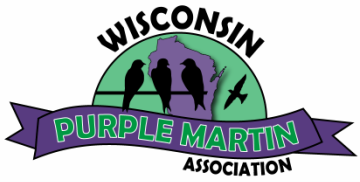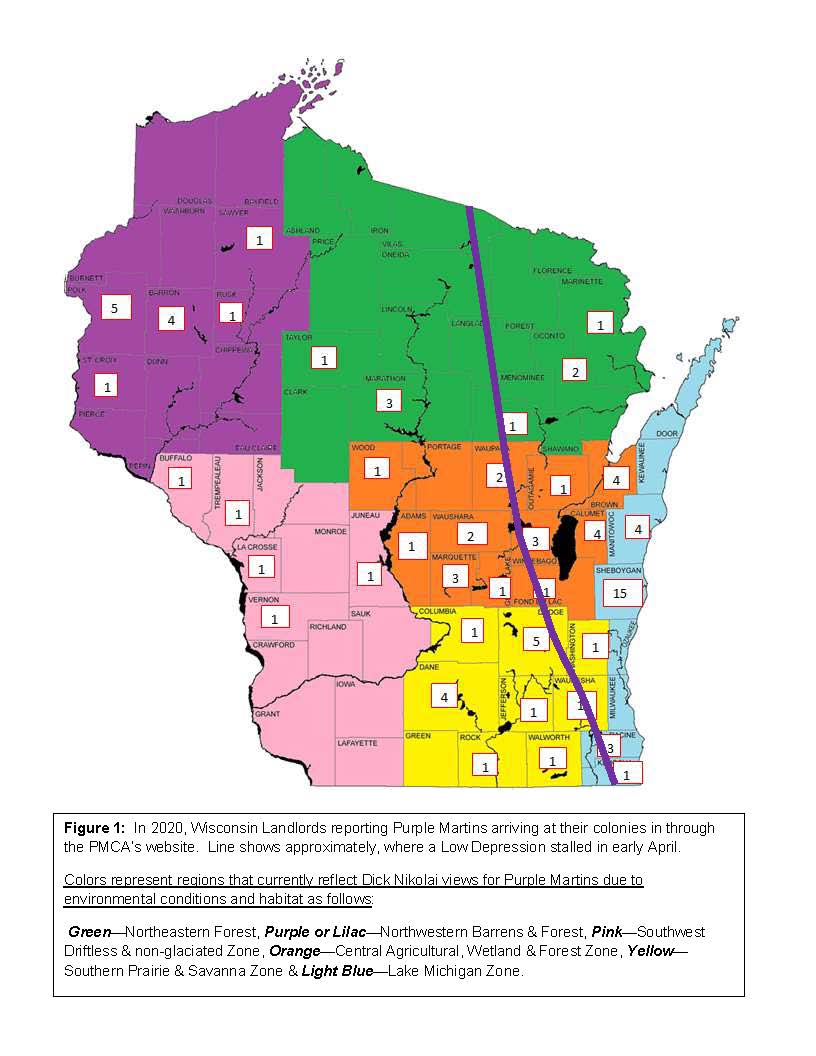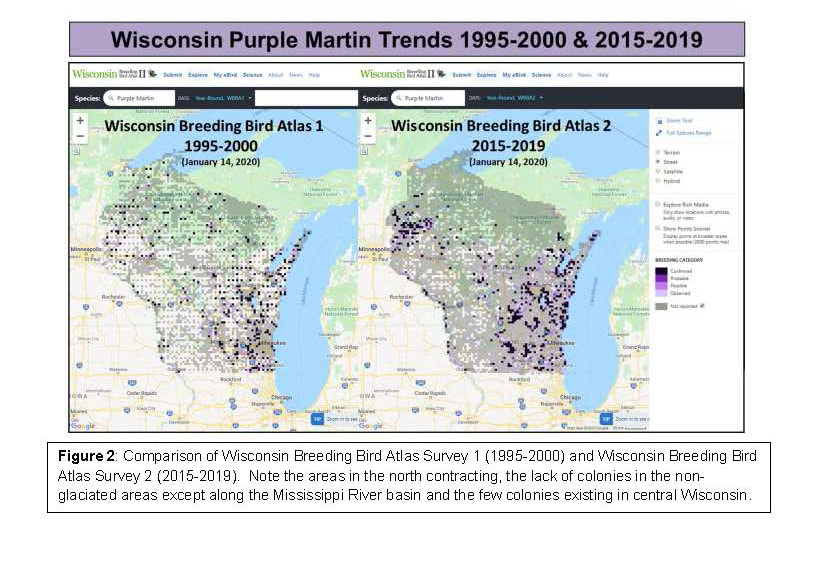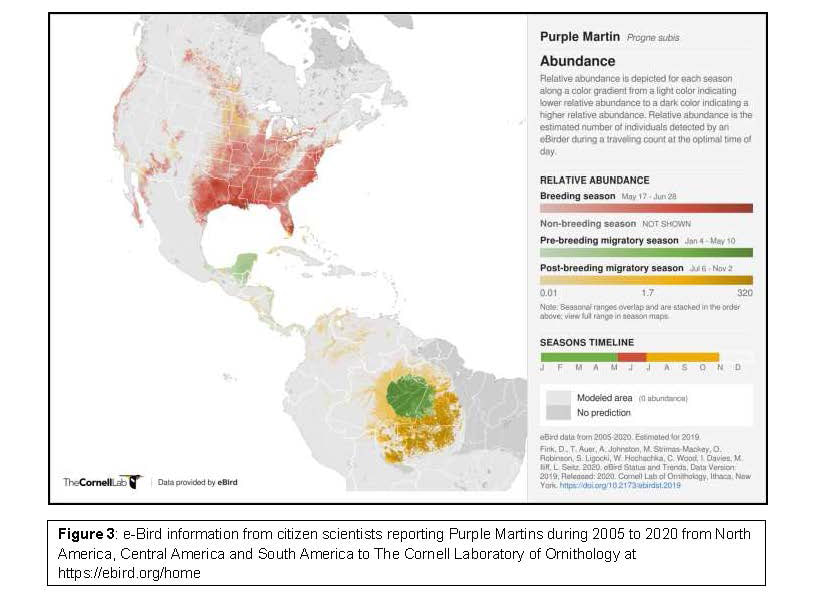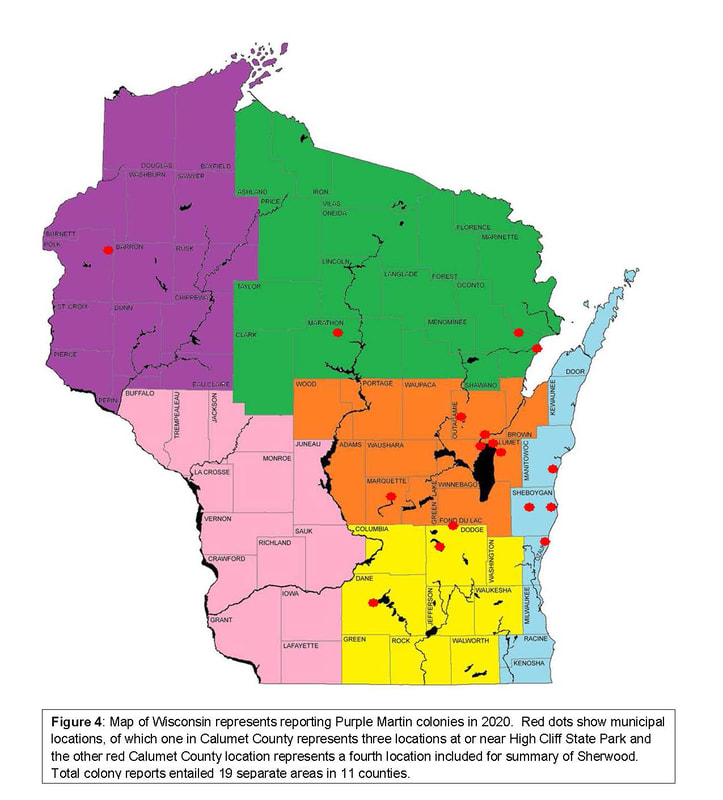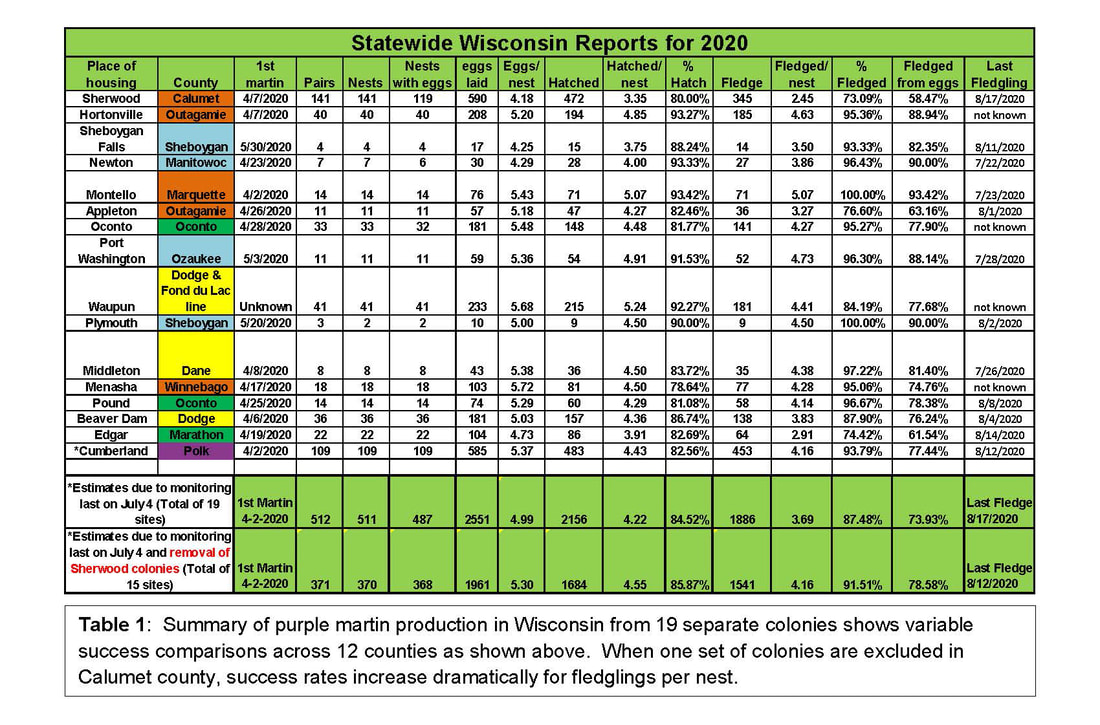Wisconsin Purple Martin (Progne subius) Statistics—2020
| Wisconsin_Purple_Martin_Statistics_2020..pdf | |
| File Size: | 878 kb |
| File Type: | |
By Dick Nikolai
Please note that statistics are representative for a time and place given by people throughout Wisconsin. They vary by region and by how each individual may have calculated their numbers given to me. This is our snapshot for 2020 given by over fifteen people with their data. I hope that it gives all of you a better insight of Wisconsin on how our Purple Martins are doing and may not reflect your own colony.
Larger colonies typically have more predation compared to smaller colonies and more interactions that are dynamic due to the habitat locally. Weather always plays a factor along with the age of the colony and its tolerances of human interactions. Some colonies are only affected by the homeowner or colony landlord. They may or may not cause positive or negative values by what they do. Public versus private colonies are subjected in different ways and circumstances those Purple Martins are adjusted. Last of all Purple Martins are individuals and we as guardians over them do influence their life styles and behaviors on how we may manage them. This possibly may influence their genetics on how their future is shaped. Remember Purple Martins are wild birds that travel thousands of miles to another continent. They are not owned by you but owned by all of us. We need to follow the laws and regulations pertaining to the Migratory Bird Treaty both federally and within our state.
Finally keep in mind that all Purple Martins need the greatest amount of variability to adapt. When we reduce that variability by our actions as we address human features on them, are we then directing their populations to a suitable outcome for their benefit?
As you see by my writings, I am trying to get all of us to appreciate Purple Martins as part of our environment. Since Purple Martins have been with me forever, I want the information presented to be a static situation where we can evaluate and learn. For 2020, it was cooler and wetter than normal when Purple Martins came to Wisconsin in April, May and early June. This had a big influence on their success throughout the breeding season contributing fledglings for the future.
From the Purple Martin Association (PMCA) website for 2020, Purple Martins were first recorded in Wisconsin on April 2. Sightings occurred in Barron, Green Lake and Marquette counties. At that time, the eastern portion of Wisconsin was having east winds and a Low Depression stalled over Lake Michigan (Figure 1) while the other side had southerly breezes with warmer temperatures. It was not until three days later on April 5 that the first Purple Martins entered eastern Wisconsin. On April 6th and 7th, the front cleared and Purple Martins began flooding the whole state in the days and months following. Overall, for 2020, 86 people reported their first Purple Martin in Wisconsin. The coloration of the map is my personal vision on how the state is divided by county lines for Purple Martins. These encompass the cool impacts from Lake Michigan shown in the light blue. The Central Agricultural zone with concentrations of wetlands and forest are shown in orange. The Northeastern Forest zone is shown in green. The Northwestern Barrens and Forest is shown in purple or lilac. The Southwest Driftless or non-glaciated Zone is shown in pink. Finally, the Southern zone, which is the heart of the former prairie and savanna, is near high population centers.
Please note that statistics are representative for a time and place given by people throughout Wisconsin. They vary by region and by how each individual may have calculated their numbers given to me. This is our snapshot for 2020 given by over fifteen people with their data. I hope that it gives all of you a better insight of Wisconsin on how our Purple Martins are doing and may not reflect your own colony.
Larger colonies typically have more predation compared to smaller colonies and more interactions that are dynamic due to the habitat locally. Weather always plays a factor along with the age of the colony and its tolerances of human interactions. Some colonies are only affected by the homeowner or colony landlord. They may or may not cause positive or negative values by what they do. Public versus private colonies are subjected in different ways and circumstances those Purple Martins are adjusted. Last of all Purple Martins are individuals and we as guardians over them do influence their life styles and behaviors on how we may manage them. This possibly may influence their genetics on how their future is shaped. Remember Purple Martins are wild birds that travel thousands of miles to another continent. They are not owned by you but owned by all of us. We need to follow the laws and regulations pertaining to the Migratory Bird Treaty both federally and within our state.
Finally keep in mind that all Purple Martins need the greatest amount of variability to adapt. When we reduce that variability by our actions as we address human features on them, are we then directing their populations to a suitable outcome for their benefit?
As you see by my writings, I am trying to get all of us to appreciate Purple Martins as part of our environment. Since Purple Martins have been with me forever, I want the information presented to be a static situation where we can evaluate and learn. For 2020, it was cooler and wetter than normal when Purple Martins came to Wisconsin in April, May and early June. This had a big influence on their success throughout the breeding season contributing fledglings for the future.
From the Purple Martin Association (PMCA) website for 2020, Purple Martins were first recorded in Wisconsin on April 2. Sightings occurred in Barron, Green Lake and Marquette counties. At that time, the eastern portion of Wisconsin was having east winds and a Low Depression stalled over Lake Michigan (Figure 1) while the other side had southerly breezes with warmer temperatures. It was not until three days later on April 5 that the first Purple Martins entered eastern Wisconsin. On April 6th and 7th, the front cleared and Purple Martins began flooding the whole state in the days and months following. Overall, for 2020, 86 people reported their first Purple Martin in Wisconsin. The coloration of the map is my personal vision on how the state is divided by county lines for Purple Martins. These encompass the cool impacts from Lake Michigan shown in the light blue. The Central Agricultural zone with concentrations of wetlands and forest are shown in orange. The Northeastern Forest zone is shown in green. The Northwestern Barrens and Forest is shown in purple or lilac. The Southwest Driftless or non-glaciated Zone is shown in pink. Finally, the Southern zone, which is the heart of the former prairie and savanna, is near high population centers.
Another way of looking at presence of Wisconsin Purple Martins is shown in Wisconsin Breeding Bird Atlas 2 conducted from 2015 to 2019 (Figure 2). We are losing colonies presence in the northern third of the state. When springs are bad, influence of cold waters of Lake Superior, landowners who move or pass away, housing is not maintained, alien species take over housing like sparrows and starling, lack of monitoring and many other impacts means Purple Martins will be harder to attract, especially in the north. The same can hold true for the remaining portion of Wisconsin. Remnant colonies are important no matter where they exist for they can lead to colonization to fill in the gaps. Note the areas in the north contracting, the lack of colonies in the driftless or non-glaciated areas in the southwest except along the Mississippi River basin and the few colonies existing in central Wisconsin. This may mean a colony over 50 miles or more away from an existing colony making it harder to attract or even keep a colony.
Over the past six years, emphasis has been made along the upper reaches of the Bay of Green Bay with presentations at Oconto providing people expanded knowledge of Purple Martin ecology and a source from public colonies at Oconto to assist in being able to attract this species for many. Banded Purple Martins have been reported near Crivitz and Pound in Wisconsin and Escanaba in Michigan. In the Northwestern Barrens and Forest Zone, key private and a single public colony has provided sources to maintain numbers given tornadoes and other weather phenomenon over the past few years along with several individuals relaying important educational materials in workshops. Very little education has been provided in the other areas mentioned where Purple Martin colonies are sparse. Our current pandemic with Covid-19 has not allowed expansion through individual education as we had hoped in 2020. As we go through 2021, please contact us or use the website of Wisconsin Purple Martin Association for materials, documents or sources of information to assist in improving those gaps during 2021 and the future.
Over the past six years, emphasis has been made along the upper reaches of the Bay of Green Bay with presentations at Oconto providing people expanded knowledge of Purple Martin ecology and a source from public colonies at Oconto to assist in being able to attract this species for many. Banded Purple Martins have been reported near Crivitz and Pound in Wisconsin and Escanaba in Michigan. In the Northwestern Barrens and Forest Zone, key private and a single public colony has provided sources to maintain numbers given tornadoes and other weather phenomenon over the past few years along with several individuals relaying important educational materials in workshops. Very little education has been provided in the other areas mentioned where Purple Martin colonies are sparse. Our current pandemic with Covid-19 has not allowed expansion through individual education as we had hoped in 2020. As we go through 2021, please contact us or use the website of Wisconsin Purple Martin Association for materials, documents or sources of information to assist in improving those gaps during 2021 and the future.
Another way of showing presence of Wisconsin Purple Martins is in Figure 3, which comes from The Cornell Laboratory of Ornithology showing e-Bird reports from people during 2005 to 2020. All of us can contribute to whole of Purple Martins or other bird species by reporting observations through this simple method of being a citizen scientist with time and effort in the field. This contribution assists in many ways by keeping time for being in the field to see bird species, which relates to dollars to retrieve for matched grants, our reporting makes it easier to show abundance, where species occur throughout the year, health of Purple Martins and many other aspects for reports for our learning. For us as bird enthusiasts it contributes an avenue by professionals of making decisions for the betterment of this species and others along with their continued existence within Wisconsin.
As we can see from the map compiled from the past 16 years, Wisconsin has huge gaps in those areas I mentioned before above Highway 64. Again, Lake Superior has influential impacts showing the demise of Purple Martins in the north by not being recorded or few records from citizen scientists. The Southwest
Driftless or non-glaciated Zone to the Wisconsin River shows a similar lack of reporting. Where Purple Martins are reported is from population centers in the southeast, south-central and west-central portions of Wisconsin. With e-Bird emphasis from us or other citizen scientists in absent areas, we may be able to see success of any expansion of future colonies and any effort we have towards educational processes to bring Purple Martins back to where they were over 50-years ago.
As we can see from the map compiled from the past 16 years, Wisconsin has huge gaps in those areas I mentioned before above Highway 64. Again, Lake Superior has influential impacts showing the demise of Purple Martins in the north by not being recorded or few records from citizen scientists. The Southwest
Driftless or non-glaciated Zone to the Wisconsin River shows a similar lack of reporting. Where Purple Martins are reported is from population centers in the southeast, south-central and west-central portions of Wisconsin. With e-Bird emphasis from us or other citizen scientists in absent areas, we may be able to see success of any expansion of future colonies and any effort we have towards educational processes to bring Purple Martins back to where they were over 50-years ago.
Many thanks go out to those individuals who have taken their time in reporting their colony results in 2020. This assists other individuals in seeing how they compared to the state, county or nearby in a municipality summary. As people who know me, I tell them this is a snapshot in time on how we collectively provide assistance for Purple Martins. Earlier I provided many parameters, which come in to factor our success. No one area is under the same conditions. Our first Purple Martins came in on April 2 with the last fledglings going out on August 17. From this report (Table 1—2nd to last summary), we collectively produced 2447 eggs from our population of 490 pairs of Purple Martins that created 489 nests with 465 pairs actually having eggs placed in the nest. Remember not all Purple Martins nesting lay eggs. This is a direct result of weather impacts, age of the pairs, disturbance by predators, disease, health, timing and other factors on them. Noting collectively that 4.99 eggs were laid per nest shows potential productivity was high with the distribution of ages of those Purple Martins within the various colonies. Spring weather did have an impact, for 2070 young were hatched at an 84.59% probably due to infertility or addling due to the eggs not be kept warm during incubation. Adults need to keep themselves well fed in order to keep up with the rigors of success. Without the adults’ survival, the young will not be able to make it unless we interfere when one or both adults are lost. Hatching was still decent at 4.23 young per nest with eggs aiming at a desired potential. Overall 1822 young Purple Martins did fledge from the reports. On the average, it is a potential of 95 young per colony site coming back if all survive. Actual survival of the young is approximately 25% or about 455 young will survive to come back to Wisconsin in 2021 from the reporting colonies. Combining this with approximately 50% losses of the adults would mean the total of the original pairs that may return would be 490 adults. With those figures, we have a deficit of 35 adults. Losses are long-term calculations that vary on yearly basis. Then you can understand the predicament that we are not adequately replacing our Purple Martin population within Wisconsin. Survival each year again is dependent on those aspects mention before. This is a constant variable and many colonies were not reported within Wisconsin. Therefore, we need to step back and hope that unreported colonies were more successful otherwise; we may see fewer Purple Martins in 2021. Population dynamics in wildlife populations always need to look at the overall process and find the problems along the way.
Looking at it another way (Table 1—Bottom summary), I eliminated the colonies at Sherwood in the report as we are meticulous in watching our colonies providing higher mortality than most people do. Given that set of circumstances, 368 pairs had 5.30 eggs in their nests for 1961 of 371 total pairs present. Of these eggs, a total hatch of 85.87% bringing 1684 young at a clip of 4.55 young per nest. Those 368 nests with eggs yielded 1541 young fledglings at 91.51% from hatchlings and a rate of 78.58% from eggs. This yield was 4.16 young fledglings per nest. Therefore, when spring 2021 arrives the 25% survival rate would bring 385-second year Purple Martins back plus another 371 adults for a plus margin of 14 additional birds. I hope that this shows you that populations at a particular site may have a deficit while the others have a surplus. This is the variability in the total population calculated by the sum of the whole. In my perspective 2020, was an average year for the entire population in Wisconsin. Rarely have we had Purple Martin populations at status quo or above for three years in a row. It has been several decades since that has occurred like 2018, 2019 & 2020. In summary 2021 has the potential for positive values of migrating Purple Martins in Wisconsin. Those second year martins are the future for new colonies and the infusion of genetics for everyone’s existing colonies. If the colony has too high of a percentage of older birds, there can be greater chance for losses due to health and some of those may be past prime fecundity (productiveness or fertility). If too young, the colony may have less success in their production for it has not reached its highest fecundity or their experience may not be an additive one avoiding predators or sustaining or defending their nesting colony. Time will tell for the future and that depends on all of you on what you do with your colonies. Remember those Purple Martins depend on you!
Looking at it another way (Table 1—Bottom summary), I eliminated the colonies at Sherwood in the report as we are meticulous in watching our colonies providing higher mortality than most people do. Given that set of circumstances, 368 pairs had 5.30 eggs in their nests for 1961 of 371 total pairs present. Of these eggs, a total hatch of 85.87% bringing 1684 young at a clip of 4.55 young per nest. Those 368 nests with eggs yielded 1541 young fledglings at 91.51% from hatchlings and a rate of 78.58% from eggs. This yield was 4.16 young fledglings per nest. Therefore, when spring 2021 arrives the 25% survival rate would bring 385-second year Purple Martins back plus another 371 adults for a plus margin of 14 additional birds. I hope that this shows you that populations at a particular site may have a deficit while the others have a surplus. This is the variability in the total population calculated by the sum of the whole. In my perspective 2020, was an average year for the entire population in Wisconsin. Rarely have we had Purple Martin populations at status quo or above for three years in a row. It has been several decades since that has occurred like 2018, 2019 & 2020. In summary 2021 has the potential for positive values of migrating Purple Martins in Wisconsin. Those second year martins are the future for new colonies and the infusion of genetics for everyone’s existing colonies. If the colony has too high of a percentage of older birds, there can be greater chance for losses due to health and some of those may be past prime fecundity (productiveness or fertility). If too young, the colony may have less success in their production for it has not reached its highest fecundity or their experience may not be an additive one avoiding predators or sustaining or defending their nesting colony. Time will tell for the future and that depends on all of you on what you do with your colonies. Remember those Purple Martins depend on you!
While this article is lengthy, I want to leave you with additional thoughts. Please be aware of Purple Martins having aluminum bands on their legs. This may be a factor relating to Bob Ring and me but there are other Banders seeking information from them too. Table 2 shows the numbers of Purple Martins banded over the past five years in Wisconsin. While that summary seems large, only the public reports a handful of Purple Martins on a yearly basis. Some of these Purple Martins have also special auxiliary features like GPS Geolocators on their backs, color bands of many colors, especially red with white lettering or other items attached. Report any of these to the Bird Banding Laboratory at https://www.usgs.gov/labs/birdb-lab.
With many summaries for us to ponder, a recent article just came from Audubon magazine on January 14, 2021 by Lesley Evans Ogen who summarized some research from Purple Martins. Information derived from GPS Geolocators using available light sensors on 155 Purple Martins from 2008 to 2015 found that those Purple Martins when exposed to bright night-lights at their wintering areas near the time of spring migration were arriving about eight days too early. Dr. Kevin Fraser and his team involving Reyd Smith found spikes of light much brighter than moonlight. When looking at exposure of artificial bright light they found at least ten nights were encountered with brighter exposure prior to departure during the 30 days prior to spring migration. This led to eight days earlier of arriving in North America on Purple Martins breeding grounds. More light exposure was attributed due to their encounters with cities and towns relayed by the GPS Geolocators. Arriving early may mean a lack of timing for finding insects on the breeding grounds due to cold weather or exposure to the cold elements resulting in the loss of these early Purple Martins. More study or research will be needed to confirm further problems of artificial light. On end of the spectrum for Purple Martins means, we need to be vigilant in taking care of them when foul weather strikes for we do not know what they have been
through on their wintering grounds. Therefore, as my warning in the beginning, we need to be careful of what we do. All that we do has ramifications in the long term for Purple Martins, especially those in our backyards or colonies. Hope this insight provides us for making better decisions for Purple Martins.
through on their wintering grounds. Therefore, as my warning in the beginning, we need to be careful of what we do. All that we do has ramifications in the long term for Purple Martins, especially those in our backyards or colonies. Hope this insight provides us for making better decisions for Purple Martins.
Finally, when all has been planned Mother Nature may throw circumstances that may make one consider if it all is worth the effort to have Purple Martins (see Table 1 for Oconto’s contributions). For the past three years, this colony of Purple Martins has had the waters of Lake Michigan or the bay of Green Bay rising. Original placement was 40 feet from high water levels. My car is shown on May 26, 2020 at the parking lot at Oconto City Park. Riprap or large stones saved the parking area against waves breaking it apart. The debris cast in the background shows the force of windblown waves. Looking further in the background is a skid-steer loader moving rocks so the homeowner protects his home from high levels of water near where trees still hold the shoreline. Unfortunately a storm brought waves toppling one of the houses with Purple Martins already inside with nests as shown where it was by the shown red circle. Several died in the storm and we replaced the new house next to the one that withstood the storm. Purple Martins that died were frozen and sent to Flagstaff Arizona for another survey looking at necropsies of these birds. We riprapped the base on both to weather future storms and barely made it through the breeding season as waves were lapping one of them again as the last young were fledging. After the season, we moved them again near the parking lot surrounded by riprapping to prepare for 2021. Will need everyone’s hopes and thoughts talking to our Supreme Being for the upcoming season otherwise we have run out of suitable habitat for this site. Our best goes out to all of you in success for your arrivals and the season ahead but beware of potential problems!
